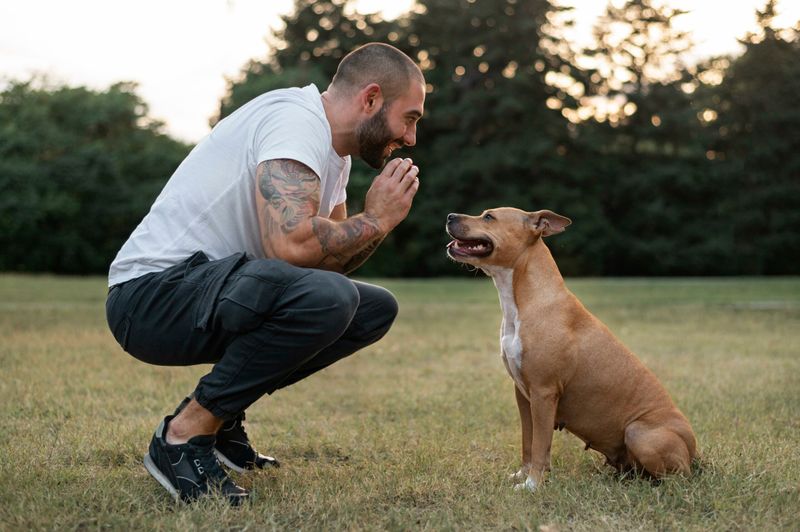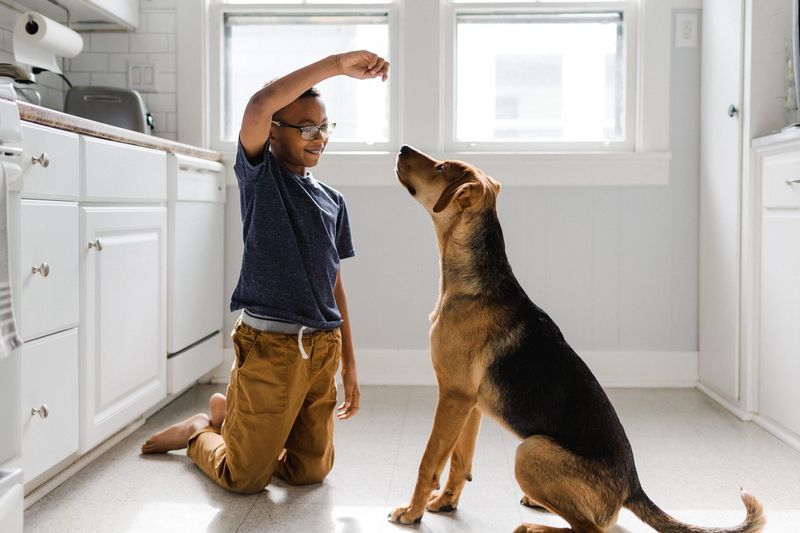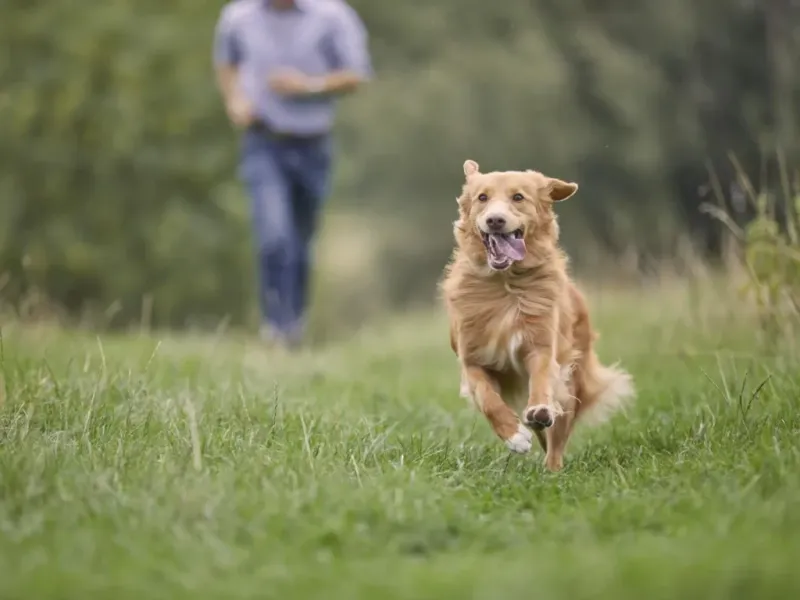Dogs are known for their incredible ability to understand human language, particularly words that are commonly used in everyday interactions with their owners. This blog post explores nine words that dogs can comprehend, demonstrating their cognitive abilities and emotional connections. Additionally, we will look at five words that remain elusive to even the most intelligent canines. Join us as we delve into the fascinating world of canine communication and discover what makes these words understandable or incomprehensible to our four-legged friends.
Sit
Does your dog sit on command? For most canines, the word “sit” is likely one of the first they learn. It’s often accompanied by a hand signal or treat, making it an easy command to grasp. Dogs associate this word with the physical act of sitting, and the reward that follows reinforces this behavior.
Training sessions often begin with this simple command, and it becomes a foundational part of a dog’s vocabulary. With practice, dogs eagerly respond to “sit,” showcasing their ability to learn and adapt to human language.
Stay
“Stay” is a word that takes determination and patience to learn. Dogs that master this command display discipline and trust in their owners. It involves staying in one spot, resisting the urge to follow or move, which can be challenging for energetic breeds.
With consistent training, dogs begin to understand “stay” as a temporary pause in their activity. This command is essential for safety, preventing dogs from bolting into dangerous situations. The satisfaction of a successful “stay” is evident in a dog’s focused gaze and calm demeanor.
Come
“Come” is a word that often brings joy and excitement. When dogs hear this command, they eagerly run towards their owners, tails wagging with delight. This command strengthens the bond between dog and owner, as it requires trust and a willingness to return.
For many dogs, “come” is associated with positive experiences like playtime or treats. It’s a word that promises fun, and dogs are quick to respond, highlighting their affectionate and loyal nature. The exuberance with which dogs embrace this command is a testament to their playful spirits.
Down
When a dog lies down on command, it’s often a sign of deep trust and obedience. The command “down” signals a change in posture that can be both calming and grounding for dogs. It’s a word that owners use to encourage relaxation and composure.
Learning “down” can take time, especially for high-energy breeds. However, once learned, it becomes an invaluable tool for managing excitement or anxiety. It’s a peaceful command that promotes tranquility, providing dogs with a moment of rest and reflection.
Heel
The command “heel” reflects a harmonious walk between owner and dog. It’s a word that teaches dogs to walk calmly by their owner’s side, leash loose and tension-free. This command is particularly useful in busy areas, ensuring the dog remains close and attentive.
Training a dog to “heel” requires patience and consistency. Over time, dogs learn to associate this word with companionship and trust. The rhythmic motion of walking in sync builds a deeper connection, making walks more enjoyable for both parties.
Fetch
“Fetch” is a word synonymous with fun and exercise. When dogs hear “fetch,” they spring into action, eager to retrieve whatever object is thrown. This command combines a dog’s natural instincts with structured play, offering both mental and physical stimulation.
Dogs of all ages enjoy a good game of fetch, which strengthens their focus and agility. The anticipation of throwing and retrieving creates a dynamic interaction, enriching the bond between human and canine. For many dogs, “fetch” is a word that brings boundless joy.
No
The word “no” serves as a boundary setter in a dog’s life. It’s a word that, when consistently used, teaches dogs what behaviors are undesirable. The tone and context in which “no” is delivered play crucial roles in its effectiveness.
Dogs often associate “no” with stopping unwanted actions, such as chewing on furniture or barking excessively. It’s a command that requires clarity and firmness, helping dogs understand limits and expectations. Through understanding “no,” dogs learn to navigate their environment with respect and mindfulness.
Leave It
“Leave it” is a command that emphasizes restraint and self-control. It’s often used to prevent dogs from picking up undesirable objects or engaging in unsafe behaviors. Mastering this command showcases a dog’s ability to prioritize its owner’s guidance over its own impulses.
The challenge of “leave it” lies in overcoming curiosity or temptation. With persistent training, dogs learn to resist immediate urges, developing patience and discipline. This command fosters a deeper sense of respect and understanding between dog and owner.
Okay
The word “okay” often signals permission or the end of a command, and dogs learn to associate it with freedom and movement. It’s a word that brings an end to a period of stillness, releasing dogs from previous restrictions.
When an owner says “okay,” it’s a moment of joy for dogs, as they transition from obedience to play or exploration. This word reinforces the trust between dog and owner, marking a shift from control to liberty. Dogs respond with enthusiasm, ready to embrace the next adventure.
Philosophy
Words like “philosophy” are beyond a dog’s understanding. Despite their intelligence, dogs do not grasp abstract concepts that are not tied to actions or objects. Such words don’t convey the clear, direct meanings dogs need to form associations.
While dogs excel with concrete commands, abstract terms leave them puzzled. The lack of physical cues or rewards means words like “philosophy” remain just sounds. Dogs thrive on immediate feedback, and without it, these words hold no meaning in their world of action and presence.
Quantum
“Quantum” is a word far removed from a dog’s comprehension. Complex scientific terms like this have no place in the canine world. Dogs focus on words that convey actions or emotions, allowing them to interact meaningfully with humans.
Terms like “quantum” lack the tangible context dogs require to understand language. Without association to physical experiences, such words are unrecognizable. Dogs rely on clear, direct communication, and abstract vocabulary simply doesn’t fit into their practical, experience-based understanding.
Algorithm
Words like “algorithm” are beyond the reach of a dog’s cognitive abilities. While canines are intelligent, their understanding hinges on tangible concepts and direct commands. Words that delve into technology or abstract ideas hold no relevance in a dog’s life.
Dogs excel with immediate, sensory experiences, making abstract and technical terms meaningless. They require simple, direct communication to form associations and fulfill tasks. As such, “algorithm” represents a realm of complexity dogs simply cannot fathom, residing outside their world of interaction and response.
Metaphor
Metaphors are tools of human language that dogs find mystifying. These figures of speech lack the directness and clarity dogs need to form associations. Dogs interpret words based on experiences, and abstract language like metaphors provides no cues for understanding.
The nuanced meanings behind metaphors are lost on canines, who thrive on straightforward communication. Without a clear action or reward tied to the word, dogs remain baffled. Thus, “metaphor” is a word that belongs to the human domain, beyond the scope of canine comprehension.
Existential
The concept of “existential” is far from a dog’s grasp. While dogs are perceptive to human emotions and actions, existential terms encompass abstract ideas that go beyond their understanding. These words carry meanings that are not tied to tangible experiences or immediate rewards.
Dogs thrive in environments where communication is clear and actionable. Without concrete associations, terms like “existential” remain nothing more than sounds. The ability to comprehend language is linked to relevance in a dog’s daily life, making abstract concepts inaccessible.














